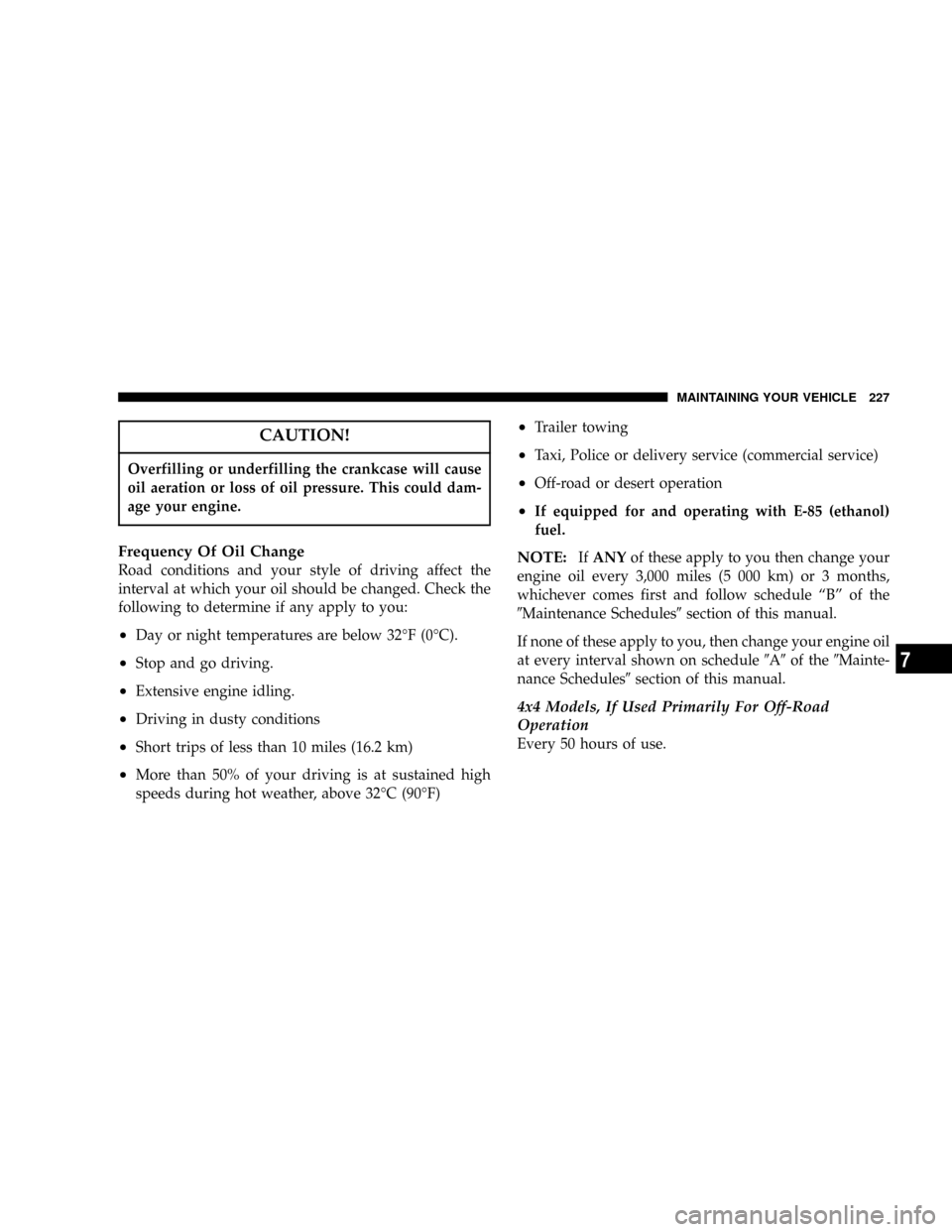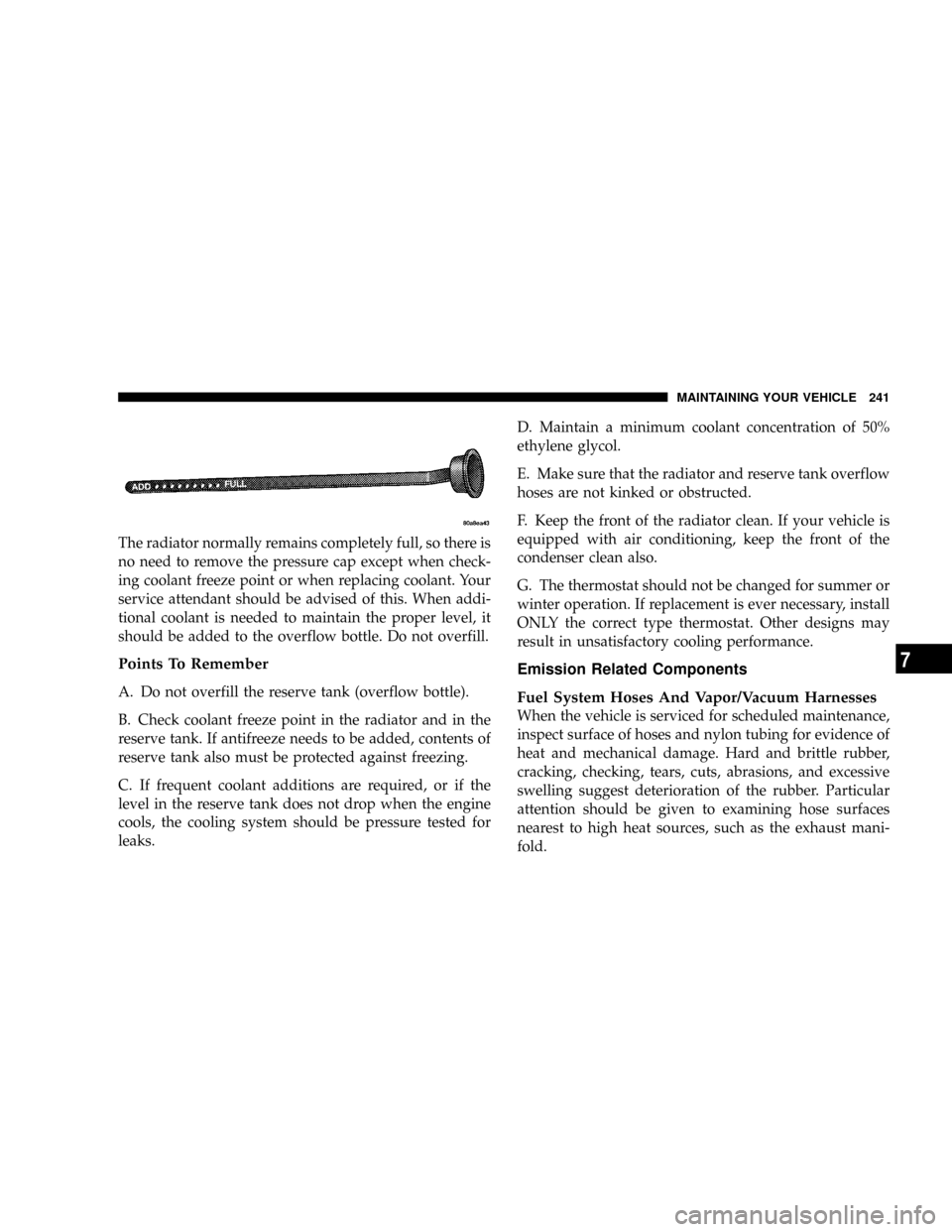2004 DODGE DAKOTA fuel pressure
[x] Cancel search: fuel pressurePage 227 of 300

CAUTION!
Overfilling or underfilling the crankcase will cause
oil aeration or loss of oil pressure. This could dam-
age your engine.
Frequency Of Oil Change
Road conditions and your style of driving affect the
interval at which your oil should be changed. Check the
following to determine if any apply to you:
²Day or night temperatures are below 32ÉF (0ÉC).
²Stop and go driving.
²Extensive engine idling.
²Driving in dusty conditions
²Short trips of less than 10 miles (16.2 km)
²More than 50% of your driving is at sustained high
speeds during hot weather, above 32ÉC (90ÉF)
²Trailer towing
²Taxi, Police or delivery service (commercial service)
²Off-road or desert operation
²If equipped for and operating with E-85 (ethanol)
fuel.
NOTE:IfANYof these apply to you then change your
engine oil every 3,000 miles (5 000 km) or 3 months,
whichever comes first and follow schedule ªBº of the
9Maintenance Schedules9section of this manual.
If none of these apply to you, then change your engine oil
at every interval shown on schedule9A9of the9Mainte-
nance Schedules9section of this manual.
4x4 Models, If Used Primarily For Off-Road
Operation
Every 50 hours of use.
MAINTAINING YOUR VEHICLE 227
7
Page 241 of 300

The radiator normally remains completely full, so there is
no need to remove the pressure cap except when check-
ing coolant freeze point or when replacing coolant. Your
service attendant should be advised of this. When addi-
tional coolant is needed to maintain the proper level, it
should be added to the overflow bottle. Do not overfill.
Points To Remember
A. Do not overfill the reserve tank (overflow bottle).
B. Check coolant freeze point in the radiator and in the
reserve tank. If antifreeze needs to be added, contents of
reserve tank also must be protected against freezing.
C. If frequent coolant additions are required, or if the
level in the reserve tank does not drop when the engine
cools, the cooling system should be pressure tested for
leaks.D. Maintain a minimum coolant concentration of 50%
ethylene glycol.
E. Make sure that the radiator and reserve tank overflow
hoses are not kinked or obstructed.
F. Keep the front of the radiator clean. If your vehicle is
equipped with air conditioning, keep the front of the
condenser clean also.
G. The thermostat should not be changed for summer or
winter operation. If replacement is ever necessary, install
ONLY the correct type thermostat. Other designs may
result in unsatisfactory cooling performance.
Emission Related Components
Fuel System Hoses And Vapor/Vacuum Harnesses
When the vehicle is serviced for scheduled maintenance,
inspect surface of hoses and nylon tubing for evidence of
heat and mechanical damage. Hard and brittle rubber,
cracking, checking, tears, cuts, abrasions, and excessive
swelling suggest deterioration of the rubber. Particular
attention should be given to examining hose surfaces
nearest to high heat sources, such as the exhaust mani-
fold.
MAINTAINING YOUR VEHICLE 241
7
Page 242 of 300

Insure nylon tubing in these areas has not melted or
collapsed.
Inspect all hose clamps and couplings to make sure they
are secure and no leaks are present.
NOTE:Fluids such as oil, power steering fluid, and
brake fluid are used during assembly plant operations to
ease the assembly of hoses to couplings. Therefore, oil
wetness at the hose-coupling area is not necessarily an
indication of leakage. Actual dripping of hot fluid when
systems are under pressure (during vehicle operation),
should be noted before hose is replaced based on leakage.
You are urged to use only manufacturer specified hoses
and clamps, or their equivalent in material and specifi-
cation, in any fuel system servicing. It is mandatory to
replace all clamps that have been loosened or removed
during service. Care should be taken in installing new
clamps to insure they are properly torqued.
Positive Crankcase Ventilation (PCV) Valve
Proper operation of the crankcase ventilation system
requires that the PCV valve be free of sticking or plug-
ging because of deposits. Deposits can accumulate in thePCV valve and passage with increasing mileage. Have
the PCV valve, hoses, and passages checked for proper
operation at the intervals specified. If the valve is
plugged or sticking, replace with a new valve.Do not
attempt to clean the oil PCV valve!Check ventilating
hose for indication of damage or plugging with deposits.
Replace if necessary.
242 MAINTAINING YOUR VEHICLE
Page 264 of 300

CAUTION!
Failure to perform the required maintenance items
may result in damage to the vehicle.
At Each Stop for Fuel
²
Check the engine oil level about 5 minutes after a fully
warmed engine is shut off. Checking the oil level while
the vehicle is on level ground will improve the accu-
racy of the oil level reading. Add oil only when the
level is at or below the ADD or MIN mark.
²Check the windshield washer solvent and add if
required.
Once a Month
²
Check tire pressure and look for unusual wear or
damage.
²Inspect the battery and clean and tighten the terminals
as required.
²Check the fluid levels of coolant reservoir, brake
master cylinder, and transmission and add as needed.
²Check all lights and all other electrical items for correct
operation.
At Each Oil Change
²
Change the engine oil filter.
²Inspect the exhaust system.
²Inspect the brake hoses.
²Inspect the CV joints (if equipped) and front suspen-
sion components.
²Check the automatic transmission fluid level (if
equipped).
²Check the manual transmission fluid level (if
equipped).
²Check the coolant level, hoses, and clamps.
Tire Rotation
²
Rotate the tires every 6,000 miles (10 000 km).
264 MAINTENANCE SCHEDULES
8
M
A
I
N
T
E
N
A
N
C
E
S
C
H
E
D
U
L
E
S
Page 288 of 300

Adding Engine Coolant (Antifreeze)......... 239
Adding Fuel........................186,208
Air Conditioner Maintenance.............. 233
Air Conditioning....................... 134
Air Conditioning, Operating Tips........135,137
Air Conditioning Refrigerant.............. 234
Air Conditioning System................. 134
Air Pressure, Tires...................176,182
Airbag...........................31,34,102
Airbag Light........................... 38
Airbag On/Off Switch.................... 34
Alarm.............................21,102
Alarm, Panic........................... 19
Alignment and Balance.................. 181
Alterations/Modifications, Vehicle............ 5
Antifreeze (Engine Coolant)............238,258
Anti-Lock Brake System...............164,165
Anti-Lock Warning Light................. 102
Anti-Theft System....................21,102
Appearance Care....................... 249
Automatic Dimming Mirror................ 59
Automatic Transmission............144,146,245
Adding Fluid........................ 246Fluid and Filter Changes................ 247
Fluid Level Check..................... 245
Fluid Type.......................247,260
Gear Ranges......................... 147
Overdrive........................... 148
Shifting............................ 146
Special Additives..................... 247
Torque Converter..................... 149
Axle Fluid............................ 260
Axle Lubrication....................... 248
Backfire, Engine........................ 190
Ball Joints............................ 235
Battery............................... 232
Charging........................... 215
Emergency Starting.................... 215
Gas Caution......................... 215
Keyless Transmitter Replacement.......... 21
Saving Feature........................ 68
Belts, Drive........................... 230
Belts, Seat............................. 25
Body Mechanism Lubrication.............. 235
B-Pillar Location....................... 172
288 INDEX
Page 292 of 300

Turn Signal.......................... 99
Flat Tire Stowage....................... 215
Flooded Engine Starting.................. 145
Floor Console.......................... 88
Fluid, Brake........................... 260
Fluid Capacities........................ 258
Fluid Level Checks
Automatic Transmission................ 245
Brake.............................. 243
Cooling System....................... 237
Power Steering....................... 234
Transfer Case........................ 248
Fog Lights..........................69,257
Four Wheel Drive...................... 151
Operation........................... 151
Four-Way Hazard Flasher................. 208
Freeing A Stuck Vehicle.................. 167
Front Axle............................ 248
Fuel................................. 184
Adding............................. 186
Filler Cap........................... 186
Filter.............................. 231
Gasoline............................ 184Gauge............................. 100
Materials Added...................... 186
Octane Rating........................ 259
Requirements.....................184,258
System Hoses........................ 241
Tank Capacity........................ 258
Fuses................................ 253
Garage Door Opener..................... 81
Gasoline............................. 184
Gasoline, Reformulated.................. 184
Gauges
Coolant Temperature................... 99
Fuel............................... 100
Oil Pressure......................... 100
Speedometer......................... 100
Tachometer.......................... 99
Voltmeter............................ 99
Gear Ranges........................100,147
Glass Cleaning......................... 251
GVWR............................... 191
Hazard Warning Flasher.................. 208
292 INDEX
Page 298 of 300

Transfer Case........................ 151
Transfer Case, Shifting into Transfer
Case Neutral (N).................... 202
Transfer Case, Shifting out of Transfer
Case Neutral (N).................... 204
Shoulder Belt Upper Anchorage............. 29
Signals, Turn......................70,99,256
Sliding Rear Window..................... 23
Snow Chains.......................... 182
Snow Plow........................... 201
Snow Tires............................ 183
Spare Tire............................ 210
Spark Plugs........................... 230
Specifications
Fuel............................... 184
Speed Control.......................... 74
Speedometer.......................... 100
Starting.............................. 144
Emergency (Jump Starting).............. 215
Engine Block Heater................... 146
Steering
Column Controls...................... 70
Column Lock......................... 11Linkage............................ 235
Power...........................166,234
Wheel, Tilt........................... 73
Steering Wheel Mounted Sound System
Controls............................ 130
Storage Compartment, Center Seat........... 89
Storage, Vehicle........................ 254
Stuck, Freeing......................... 167
Supplemental Tire Pressure Information...... 182
Synthetic Engine Oil..................... 229
Tachometer............................ 99
Tailgate............................... 90
Taillights............................. 256
Tape Player........................... 131
Temperature Gauge, Engine Coolant......... 99
Tether Anchor, Child Restraint.............. 42
Thermostat........................... 241
Tilt Steering Column..................... 73
Tire and Loading Information Placard.....172,182
Tire Identification Number (TIN)........... 171
Tire Markings......................... 167
Tire Safety Information................... 167
298 INDEX